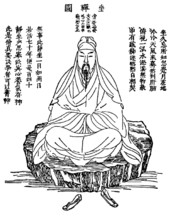Taoism includes a number of meditative and contemplative traditions, said to have their principles described in the I Ching, Tao Te Ching, Chuang Tzu and Tao Tsang among other texts. The multitude of schools relating to Qigong, Neigong, Internal alchemy, Daoyin and Zhan zhuang is a large, diverse array of breath-training practices in aid of meditation with much influence on later Chinese Buddhism and with much influence on traditional Chinese medicine and the Chinese as well as some Japanese martial arts. The Chinese martial art T'ai chi ch'uan is named after the well-known focus for Taoist and Neo-Confucian meditation, the Taijitu (T'ai Chi T'u), and is often referred to as “meditation in motion”.
"The Guanzi essay 'Neiye' 內業 (Inward training) is the oldest received writing on the subject of the cultivation of vapor and meditation techniques. The essay was probably composed at the Jixia Academy in Qi in the late fourth century B.C."
Often Taoist Internal martial arts, especially T'ai chi ch'uan
are thought of as moving meditation. A common phrase being, "movement
in stillness" referring to energetic movement in passive Qigong and
seated Taoist meditation; with the converse being "stillness in
movement", a state of mental calm and meditation in the tai chi form.
In a form of meditation using visualization, such as Chinese Qigong, the practitioner concentrates on flows of energy (Qi) in the body, starting in the abdomen and then circulating through the body, until dispersed.

No comments:
Post a Comment